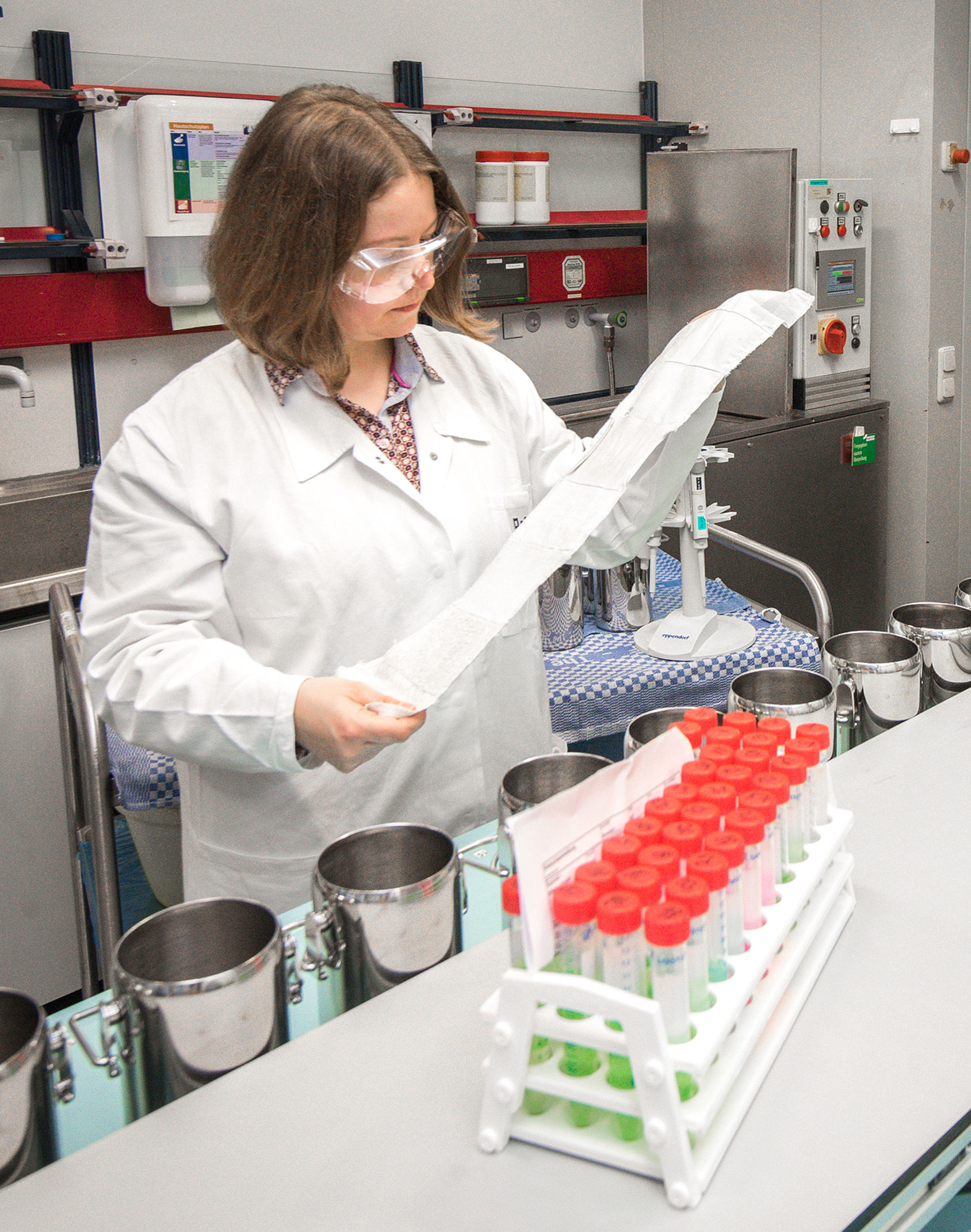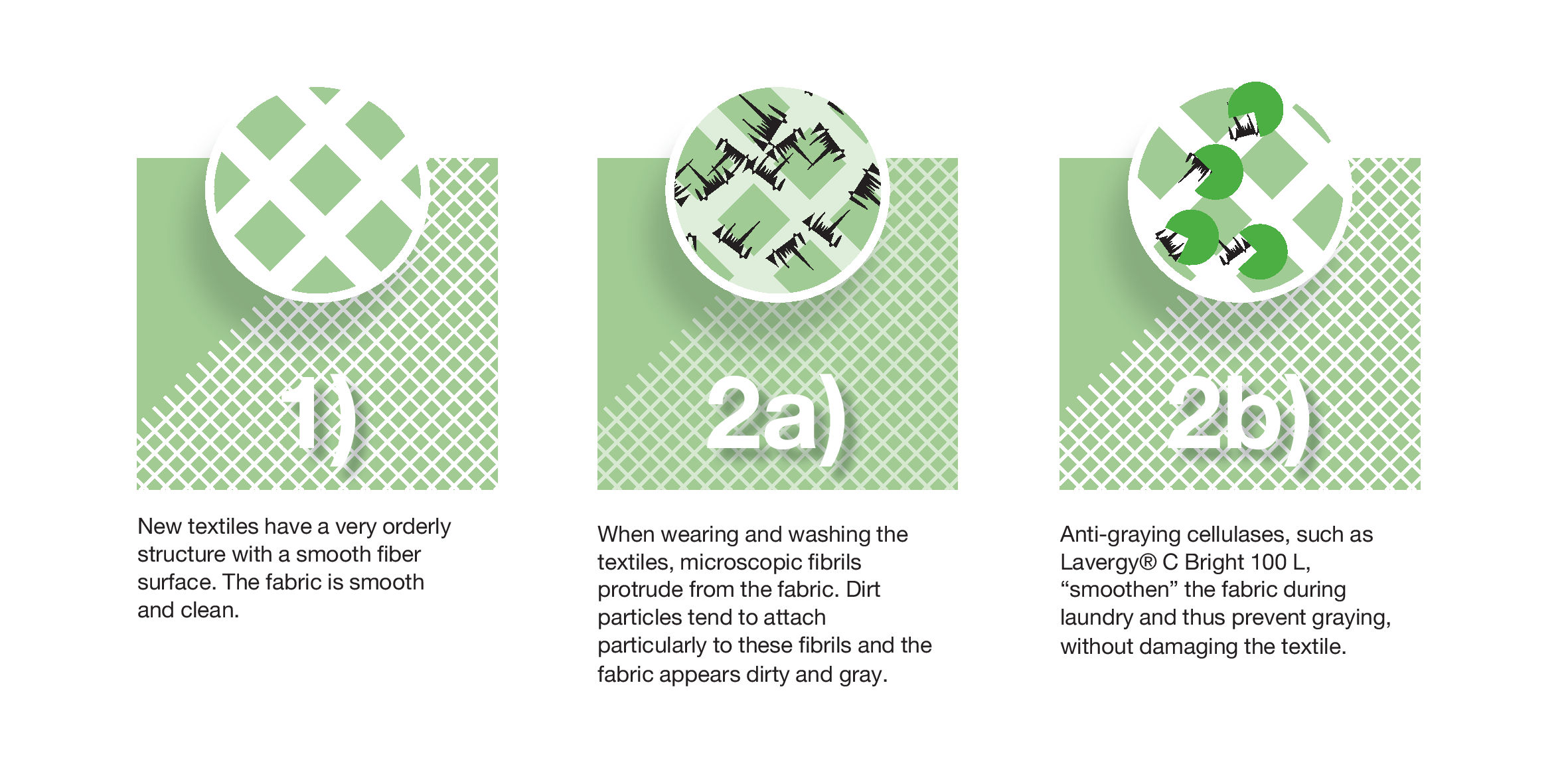Enzyme keeps textiles smooth and clean
Consumer place high demands on today’s detergents: they should be easy to use, protect the environment, and achieve excellent cleaning performance. End consumers are looking for a solution that meets all their demands. And that is exactly what the detergent experts from the Care Chemicals operating division have been working on – a solution that makes washing more sustainable, easier and more effective.
The new Lavergy® C Bright 100 L enzyme plays a decisive role in the development – with the word “bright” reflecting the enzyme’s main property. Adding Lavergy to a detergent prevents textiles from graying. “What makes Lavergy special is that it is a cellulase that helps prevent the graying of cotton,” (cf. infographic) explained Dr. Antoine Beziau, Technical Manager. Combining Lavergy with other high-quality ingredients from the BASF portfolio makes it possible for a detergent to prevent graying not only on cotton, but also on a wide range of other materials. Whether cotton or synthetic fibers, white or colored fabrics, consumers benefit from a one-fits-all detergent. And that is not the only advantage.
Lavergy is biodegradable and makes detergent formulations more sustainable when combined with conventional chemical ingredients. It is effective at low temperatures so that consumers can save energy and costs. Textiles retain their original appearance for a longer time and clothing lasts longer. In addition, detergents containing the new product meet the requirements of various eco-labels, such as the EU Ecolabel and the “Blue Angel” (German eco-label). “This is a tremendous advantage for detergent manufacturers, as today’s consumers pay considerable attention to purchasing sustainable detergents,” said Dr. Sonja Fischer, Marketing Home Care.
The product can also be used in liquid detergents. To date, there is no optimum solution for liquid detergents when it comes to protecting clothing from graying. Tests conducted by the German product testing institute “Stiftung Warentest” show that powder detergents are leading the way in this regard. Special bleaching agents are added to powder detergents in order to solve the problem, but these bleaching agents cannot be used in liquid detergents. Thanks to Lavergy® C Bright 100 L, there is now a liquid detergent solution for consumers who want to protect their clothes from graying. “Surveys show that consumers are willing to spend more money for products that are sustainable, save time, make washing easier, and achieve a good cleaning result,” said Fischer. “Our solution is an excellent tool for our customers in the detergent industry to meet all of their consumers’ demands at the same time. And by combining biology with chemistry, we bring the best of both worlds together!
How is a new product created?
The enzyme team with biologist Dr. Gabriele Boenemann and many other colleagues have worked towards this big day for the last three years. With the Lavergy® C Bright 100 L enzyme, the Care Chemicals operating division introduced a new product for the detergent industry end of 2020. The enzyme is the result of a joint project involving colleagues from a wide range of BASF units. But where does the idea for a new product come from? And how is the initial idea turned into a solution?
“It was clear from the onset that BASF would step up its activities in the promising market of detergent enzymes,” explained Darshan Patwardhan-Huber, Marketing Manager Enzymes. “Enzymes are the future in terms of detergent ingredients, especially when it comes to sustainability and innovation – and BASF wanted to develop its own solutions.” In a first step, proteases (enzymes that can remove protein stains) were developed and marketed. At the end of 2017, BASF received an order for the development of a cellulase for liquid detergents that actively prevents graying. But how exactly does such a development process work? “The first step was to test a variety of candidates to identify the enzyme with the best performance and greatest stability. Microorganisms are needed to produce these enzymes.” Boenemann explained. BASF is already using microorganisms in many other areas throughout the company.
Not necessarily an ideal environment for enzymes to maintain their stability
“In the second step, our task was to make the microorganism produce the exact enzyme we wanted,” explained Dr. Lutz Petzke, Project Manager. This process, which is also referred to as strain development, was followed by fermentation development. “Simply put, this involves finding a way to have the microorganism produce as much of the enzyme as possible from its nutrients” Dr. Edzard Scholten added, responsible for the transfer from lab scale to production scale.
In a fourth step the targeted enzyme is separated from the microorganisms and in a fifth step formulated into ready-for-sale product Lavergy® C Bright 100 L. The goal was to combine high washing performance, good product stability (even over longer storage periods and at higher temperatures) and good compatibility with other ingredients. “Detergents consist of a wide variety of ingredients, including surfactants, polymers and fragrances in an alkaline environment. This is not necessarily an ideal environment for enzymes to maintain their stability and tap their full potential,” said Patwardhan-Huber. Numerous performance and stability tests were performed to achieve the best possible result. “We tested the stability and effectiveness of enzymes based on a variety of model formulations.” This means that the compositions of these formulations resemble those of “actual” detergents currently available on the market. After all, the enzyme must deliver the desired result in a broad range of conditions.

"I am highly convinced by the anti-graying effect"
The testing process was a laborious task for the employees in the labs. Even though many of these tests can only be done in the final phase of product development, a lot of tests are also performed at an earlier stage, parallel to the first development steps. “No developer wants to work for three years before finding out that they are now capable of producing a product in sufficient quantities, but the product does not work as intended. That is why it is of utmost importance to stay in close contact with all functions over the course of the entire development process,” Boenemann added. The developers are more than satisfied with their enzyme: “Frankly, I am highly convinced by the anti-graying effect,” said Boenemann. “The hard work really paid off and the entire project team can be proud of the new product!”
This is how enzymes in detergents work:
Even the tiniest amounts of enzymes in detergents are enough to provide effective results. The enzymes are active at low temperatures, thus reducing the average detergent consumption and washing temperature. 40 percent of industrially produced enzymes are used in detergents and cleaning agents. Proteases such as subtilisins are capable of breaking down proteins, which means that they can remove blood, cocoa and egg stains. Amylases are an effective solution against starch-based stains, while fats are broken down by lipases. Two different types of cellulase are used to keep cotton fabrics like new: Anti-pilling cellulases “chew” away pills on the surface of textiles, and anti-graying cellulases prevent graying. The infographic below illustrates how the anti-graying cellulase works.

More information:
